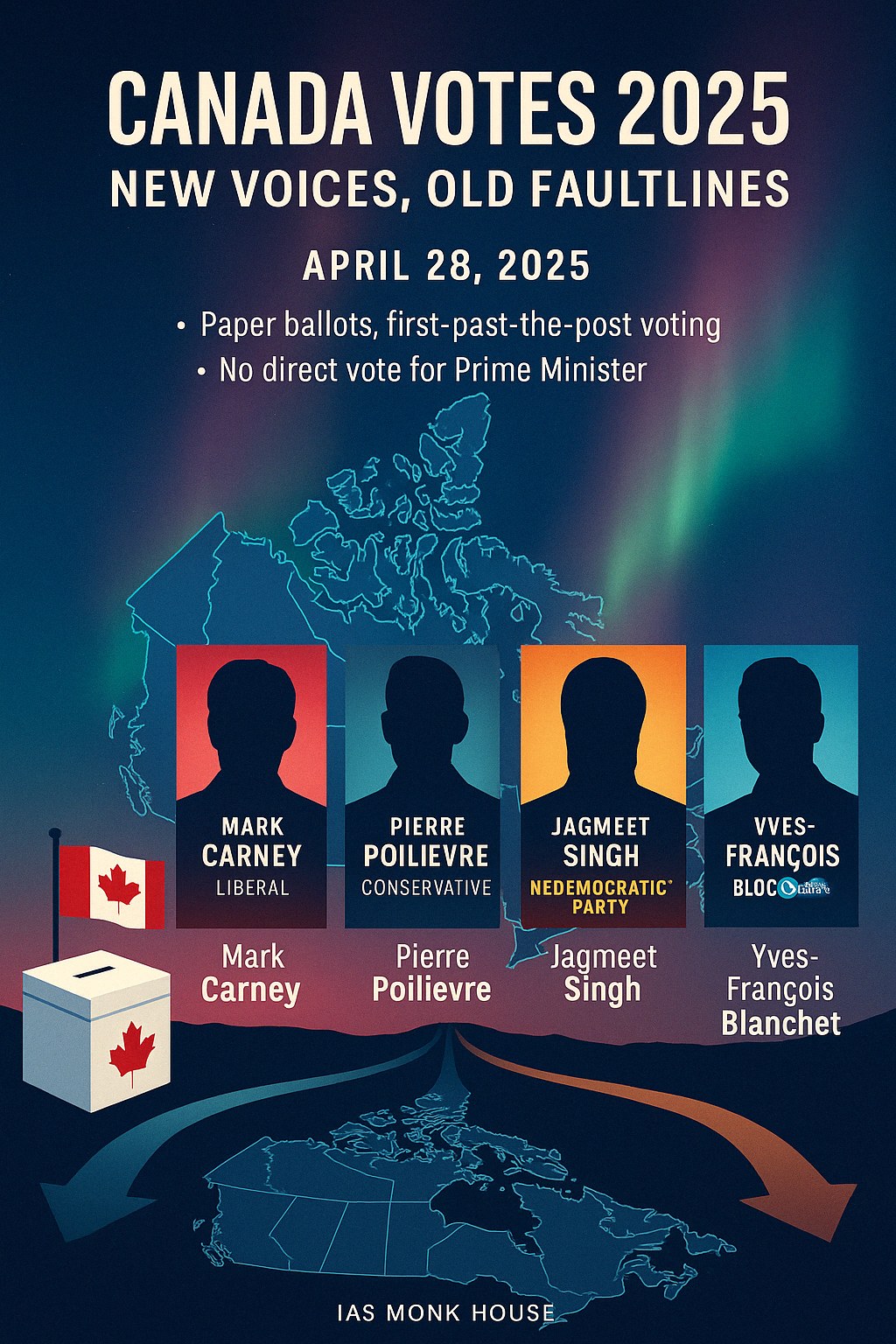
005-Apr 21, 2025
“Canada Decides: A Four-Way Crossroads in the Great North”

A tight race, a changing guard, and a quietly elegant voting system define the 2025 Canadian federal election.
🧭 Thematic Focus
Category: International Relations | Political Transitions | Democratic Systems
“Canada Votes 2025: New Voices, Old Faultlines”
April 28 voting, no direct PM vote, four leader snapshots, and riding-based “first past the post” map.
📌 Key Highlights
🗳️ Canada Votes – April 28, 2025
- Citizens vote to elect 343 MPs, using paper ballots and first-past-the-post system.
- No direct vote for Prime Minister — the party with most seats forms the government.
👤 Meet the Contenders
- Mark Carney – Liberal Party
- Former governor of Bank of England & Bank of Canada.
- New to electoral politics; viewed as a stabilising, technocratic choice.
- Faces early test amid US trade tensions and economic unease.
- Pierre Poilievre – Conservative Party
- Veteran politician, populist appeal with a promise of “common sense politics.”
- Focus on inflation, housing, and lower taxes.
- Nationalist tone, but distances from Trump comparisons.
- Jagmeet Singh – New Democratic Party
- Known for equity-driven policies; ended prior alliance with Liberals.
- Faces struggle to maintain party status with polls under 9%.
- Yves-François Blanchet – Bloc Québécois
- Quebec-only party leader, not in PM race.
- Pushes for Quebec sovereignty and trade autonomy.
🌐 The Issues Shaping the Race
- US-Canada Trade Rifts: Trump’s new tariffs raise anxieties; Carney calls for unity, Poilievre counters with economic nationalism.
- Cost of Living & Housing Crisis: Poilievre’s message lands with many working-class voters.
- Leadership Transition: Justin Trudeau is out; a new chapter opens.
- Geopolitical Pressure: Candidates offer contrasting visions on global engagement vs. domestic prioritisation.
🧠 Concept Explainer
What Makes Canada’s Democracy Unique?
Canada votes on paper ballots, hand-counted without machines or referendums. The system runs on trust, transparency, and tradition. There is no direct election for Prime Minister—only MPs are elected, and the Governor General invites the winning party’s leader to form a government.
Canada’s Structure of Government:
🏛️ 1. Parliamentary Democracy & Constitutional Monarchy
- Canada recognizes King Charles III as its Head of State, represented by the Governor General.
- The Prime Minister is the Head of Government and leads the executive branch.
🧱 2. Three Branches of Government
a) Executive
- Governor General (ceremonial head): Appointed by the monarch on the advice of the Prime Minister (not elected by public).
- Prime Minister: Leader of the party that wins most seats in the House of Commons.
- Cabinet: Ministers selected by the PM from elected MPs.
b) Legislature (Parliament)
- Bicameral:
- House of Commons (elected MPs — 343 ridings in 2025)
- Senate (appointed by PM, represents provinces/territories)
c) Judiciary
- Independent; led by the Supreme Court of Canada.
🗳️ 3. Elections and PM Selection
- Canadians do not vote directly for the Prime Minister.
- They vote for Members of Parliament (MPs) in local ridings.
- The party that wins the most seats is invited by the Governor General to form a government.
🇬🇧 4. How It Differs from the US Presidential System
| Feature | Canada (Parliamentary) | USA (Presidential) |
|---|---|---|
| Head of State | Monarch (via Governor General) | President (elected) |
| Head of Government | Prime Minister | President |
| Election of Leader | Indirect (party-based) | Direct (nationwide vote) |
| Separation of Powers | Fusion (executive + legislature) | Separation (executive ≠ legislature) |
| Confidence Votes | Can dissolve Parliament | No such mechanism in fixed term |
📜 GS Paper Mapping
- GS Paper II:
- Comparative Politics: Canada’s Parliamentary Model
- International Relations: India–Canada, US–Canada, Global Trade Dynamics
- Democracy & Elections: Electoral Systems, Coalition Governments
- GS Paper III:
- Economy: Global Trade Friction and Tariff Politics
- Governance: Leadership Transition and Policy Continuity
✍️ Essay Paper Mapping
- “In Quiet Polling Booths, Loud Choices: What Democracy Looks Like Across Borders”
- “When Trade Turns Tactical: Leadership Under Geopolitical Pressure”
- “Coalition, Confidence, and Collapse: Lessons from Minority Governments”
💭 A Thought Spark — by IAS Monk
“In the stillness of snow and ballots, a nation writes its next stanza—softly, but with the strength of democracy’s oldest pen.”

















